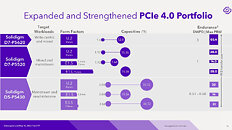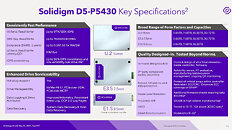TheLostSwede
News Editor
- Joined
- Nov 11, 2004
- Messages
- 17,758 (2.42/day)
- Location
- Sweden
| System Name | Overlord Mk MLI |
|---|---|
| Processor | AMD Ryzen 7 7800X3D |
| Motherboard | Gigabyte X670E Aorus Master |
| Cooling | Noctua NH-D15 SE with offsets |
| Memory | 32GB Team T-Create Expert DDR5 6000 MHz @ CL30-34-34-68 |
| Video Card(s) | Gainward GeForce RTX 4080 Phantom GS |
| Storage | 1TB Solidigm P44 Pro, 2 TB Corsair MP600 Pro, 2TB Kingston KC3000 |
| Display(s) | Acer XV272K LVbmiipruzx 4K@160Hz |
| Case | Fractal Design Torrent Compact |
| Audio Device(s) | Corsair Virtuoso SE |
| Power Supply | be quiet! Pure Power 12 M 850 W |
| Mouse | Logitech G502 Lightspeed |
| Keyboard | Corsair K70 Max |
| Software | Windows 10 Pro |
| Benchmark Scores | https://valid.x86.fr/yfsd9w |
Solidigm, a leading global provider of innovative NAND flash memory solutions, is expanding its D5 Product Series with the Solidigm D5-P5430, a new QLC solid-state storage drive (SSD) optimized for mainstream and read-intensive workloads. With most of today's enterprise applications read-dominant, the D5-P5430—a 4th gen PCIe QLC SSD—offers substantial storage density and Total Cost of Ownership (TCO) opportunities while delivering read performance that is equivalent to the most widely-adopted TLC SSDs.
The D5-P5430 is optimized for mainstream workloads (e.g., email/unified communications, decision support systems, object storage, and virtual desktop infrastructure) and read-intensive workloads (e.g., content delivery networks, data lakes/pipelines, video-on-demand). These workloads are typically 80% reads or higher and need to move massive amounts of data at high throughput.



As a drop-in replacement for TLC NAND-based PCIe-based SSDs, the D5-P5430 can reduce TCO by up to 27% for a typical object storage solution with a 1.5X increase in storage density and 18% lower energy cost. In addition, Solidigm's newest drive can deliver up to 14% higher lifetime writes vs. leading TLC SSDs.
Important data center issues like power efficiency, edge computing, and sustainability of infrastructure, all benefit from the density of the D5-P5430, which can reduce power and cooling costs and lower the number of drives needed by up to 2x when compared to alternative solutions.
"Data centers need to store and analyze massive amounts of data with cost-effective and sustainable solutions," said Greg Matson, VP, Strategic Planning and Marketing, Solidigm. "Solidigm's D5-P5430 drives are ideal for this purpose, delivering high density, reduced TCO, and 'just right' performance for mainstream and read-intensive workloads."
The D5-P5430 supports a wide range of 1U and 2U server and storage configurations with a broad range of capacities that support the following legacy and modern EDSFF form factors:
"Supermicro works with leading storage suppliers like Solidigm to bring the latest technology to our global customers that expect high-performance and secure storage technology," said Vik Malyala, Managing Director and President, EMEA; SVP, WW FAE, Supermicro. "Solidigm's new QLC-based E3.S SSD, the D5-P5430, gives customers a compelling combination of high density and efficiency for the data center infrastructure."
View at TechPowerUp Main Site | Source
The D5-P5430 is optimized for mainstream workloads (e.g., email/unified communications, decision support systems, object storage, and virtual desktop infrastructure) and read-intensive workloads (e.g., content delivery networks, data lakes/pipelines, video-on-demand). These workloads are typically 80% reads or higher and need to move massive amounts of data at high throughput.



As a drop-in replacement for TLC NAND-based PCIe-based SSDs, the D5-P5430 can reduce TCO by up to 27% for a typical object storage solution with a 1.5X increase in storage density and 18% lower energy cost. In addition, Solidigm's newest drive can deliver up to 14% higher lifetime writes vs. leading TLC SSDs.
Important data center issues like power efficiency, edge computing, and sustainability of infrastructure, all benefit from the density of the D5-P5430, which can reduce power and cooling costs and lower the number of drives needed by up to 2x when compared to alternative solutions.
"Data centers need to store and analyze massive amounts of data with cost-effective and sustainable solutions," said Greg Matson, VP, Strategic Planning and Marketing, Solidigm. "Solidigm's D5-P5430 drives are ideal for this purpose, delivering high density, reduced TCO, and 'just right' performance for mainstream and read-intensive workloads."
The D5-P5430 supports a wide range of 1U and 2U server and storage configurations with a broad range of capacities that support the following legacy and modern EDSFF form factors:
- U.2 15 mm 3.84 TB - 30.72 TB
- E1.S 9.5 mm 3.84 TB - 15.36 TB
- E3.S 7.5 mm 3.84 TB - 30.72 TB
"Supermicro works with leading storage suppliers like Solidigm to bring the latest technology to our global customers that expect high-performance and secure storage technology," said Vik Malyala, Managing Director and President, EMEA; SVP, WW FAE, Supermicro. "Solidigm's new QLC-based E3.S SSD, the D5-P5430, gives customers a compelling combination of high density and efficiency for the data center infrastructure."
View at TechPowerUp Main Site | Source



